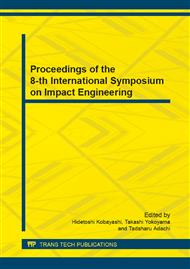p.3
p.10
p.26
p.34
p.43
p.50
p.56
p.61
Thermal Processing History and Resulting Impact Response of a Hot-Formed Component with Tailored Properties – Numerical Study
Abstract:
The impact modeling of a hot-formed component with tailored mechanical properties is studied to understand the influence of the thermal processing history and how the final properties of the component will affect its impact response. This paper presents a numerical study of the forming and quenching process and subsequent impact simulations. The processing simulations serve to predict the final microstructure and hardness distribution within a lab-scale B-pillar component that is processed using a tool with separate heated and cooled regions. A remapping algorithm is used to translate the results of the forming simulation to the impact simulation. A strain-rate sensitive material model is applied to model the response of these tailored microstructures during impact events. A comparison between a component that is fully hardened and a tailored component with regions of lower strength but increased ductility is presented in this work. Simulations that do not consider the onset of fracture predict superior peak impact load and energy absorption of the fully martensitic component due to its higher overall strength. However, the bainitic regions within the tailored component exhibit much higher ductility. Current work is addressing the introduction of failure criteria into simulations of tailored hot stamped components under impact loading for which the tailored component is expected to demonstrate superior resistance to cracking relative to the fully hardened component.
Info:
Periodical:
Pages:
34-40
Citation:
Online since:
June 2014
Price:
Сopyright:
© 2014 Trans Tech Publications Ltd. All Rights Reserved
Share:
Citation:


